Roadtrip, Part 2
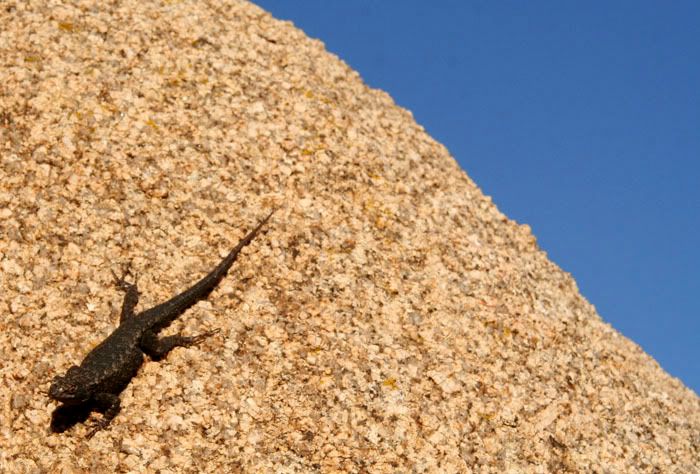
One of my goals in this trip was to catch a glimpse of some American wildlife. However, since Yellowstone and the Everglades were too far out of the way, I had to research some places in the Southwest where it would be possible to see some animals.
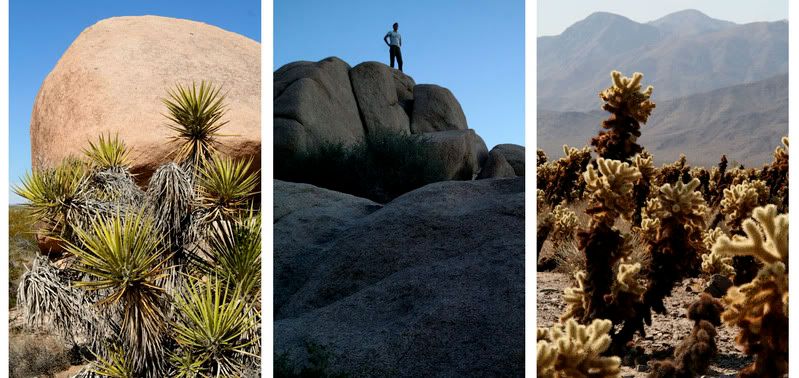
Our first night camping in the desert was spent in Joshua Tree. We got to the park offices after closing, put grabbed one of the maps of campsites left beside the locked door. Outside of the park offices a family of quails was running around the parking lot, terrified of us. The father bravely tried to lead us away, leaving his wife and a small flock of tiny quail chicks chirping fearfully. The mother managed to jump into a planter, but the chicks were too small- they hopped and leaped, but only managed to knock their bodies against the planter's concrete side. After terrorizing them with our cameras, we headed into the park. We got to the campsite just as the sun was setting, the mountainous boulder landscape fading to blue. We set up our tent in a hidden spot between rocks, and gathered kindling for a fire before the sun set. While heating the coals, Bordeaux looked over my shoulder, and saw a silhouette on the rock behind me. A kitfox was watching us, its thin body arched as it looked down at us.

The next morning, after walking through a carefully mapped out cholla garden, we drove south out of the park. We took minor roads, through rocky valleys and quiet desert passes. Somewhat abruptly, scrub desert was replaced with manicured green fields as we approached the town of Mecca. Beyond the fields of green, seeming a mirage, spread the Salton Sea. As we approached it, we found quiet seafront towns, where mobile homes far outnumbered permanent structures. The shoreline was littered with crumbling yacht clubs and boarded up motels, the perfect setting for enacting a post-apocalyptic fantasy. Bordeaux and I parked outside of a desolate motel, home now to abandoned appliances and a commune of pigeons.
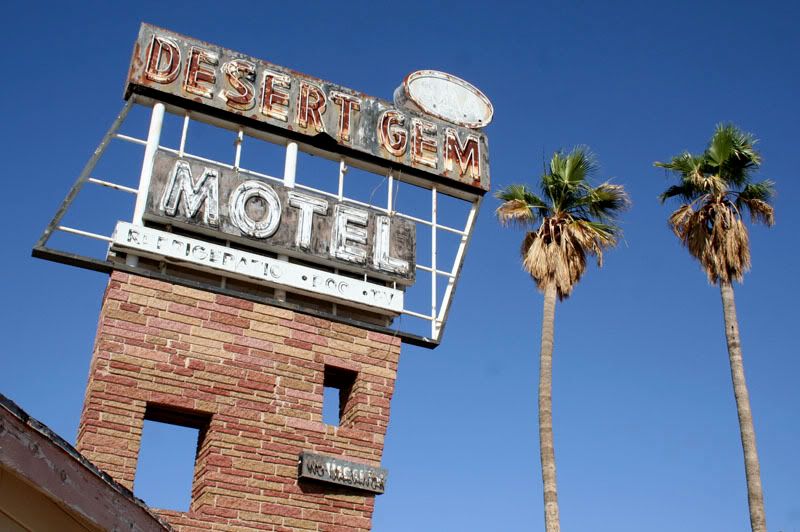
The situation was not much different in Gila Bend, AZ, where we found the deserted Desert Gem Motel. A mod '60s motel, fenced up and emptied out (aside from a few squatter residents).
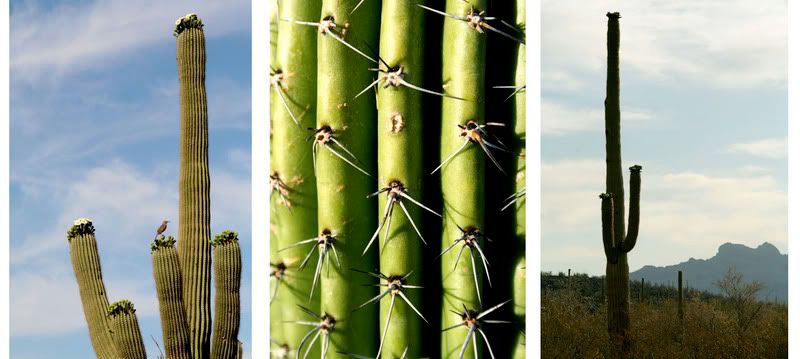
From Gila Bend we curved south, on the lonely highway to Organ Pipe. We passed through quiet towns, whose main source of income seemed to be selling insurance for travelers going to Mexico. We drove far south, nearly to the border of Mexico. Border Patrol trucks lumbered past us, in search of illegal crossings. Bordeaux spotted a coyote (not the kind the Border Patrol was looking for), standing at the side of the road. After a lonely drive through bizarre cactus forest, we finally reached quiet Organ Pipe, sanctuary for peccary Sonoran Pronghorn.
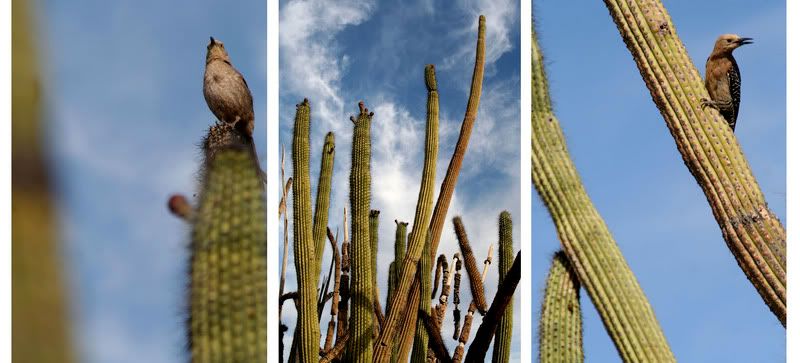
In contrast to the abandoned motels and past-primes towns that Bordeaux and I had seen, every inch of the desert seemed to be alive. Cacti and scrub brush grew from every inch of soil, in strange shapes and surprising colors. While we didn't see any larger mammals (no pronghorn of peccary, sadly), I was amazed by the amount of life we saw in the desert. I've never seen Disney's documentary The Living Desert, but it reminded me of that. While looking at a massive organ pipe cactus, we saw a mouse slipping into his nest, a woodpecker searching for a meal, and bees and wrens feeding at the blossoms. At night we were visited by a skittish kangaroo rat, and a fat surly toad.
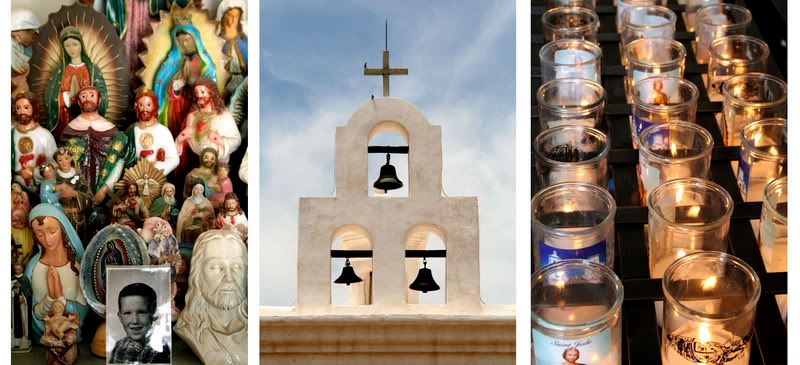
From Organ Pipe we drove north, through the town of Why (along a highway sponsored by the group 'Why Senior Citizens'). The side of the highway was dotted by altars and crosses, colorful graves marked with portraits and memorabilia from the life of the dead. Skirting the southern border of Arizona, we eventually arrived in Tucson, where our car radio picked up an NPR affiliate, begging for donations in terms that its listeners would understand ("Just give up that one chai latte a week!"). Turning south, we entered the San Xavier reservation. Though the mission church at San Xavier was under restoration, it was still an impressive sight- a cool white adobe structure, decorate with terra cotta saints and carved wooden trim. Outside the garden was filled with strange purple prickly pear, and beautifully manicured cholla. Inside the chapel, we found an elaborate altar, populated by a town of Catholic kitsch: ceramic Jesuses and luridly painted Marys, lit by dozens of tiny candles.
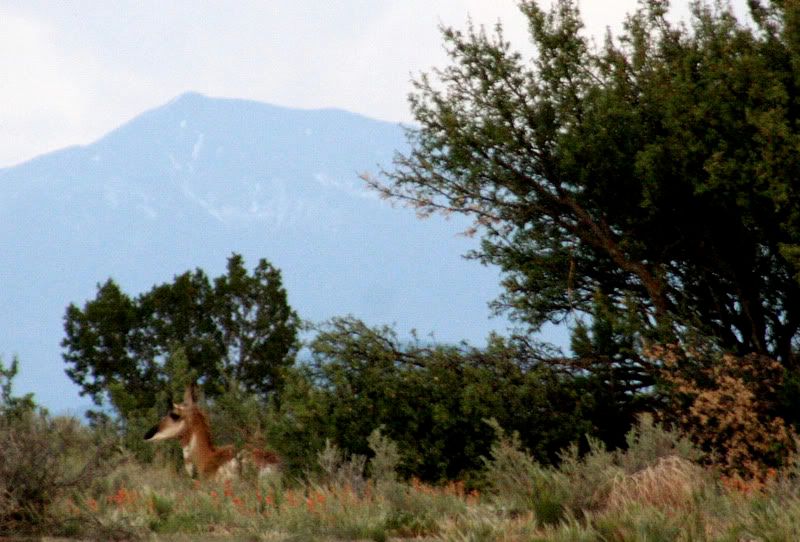
Finally, the next day, I got my large mammal sighting. Under dark clouds and shuddering thunder, we drove north to the Grand Canyon. Just past Flagstaff, where pine forests gave way to flat grassland, Bordeaux spotted two animals galloping across a distant ridge. Realizing what they were, I hastily pulled the civic to the side of the road. A thin pronghorn antelope, the fastest North American mammal, was posing at some distance from us. It's silhouette, svelte form and stubby horns, stood out against the blue mountains beyond. Of course, as I got out my camera, the pronghorn went in front of some bushes and laid down to rest, and I was able in the end to produce only this sad, blurry photo of it tucked between wildflowers and pinon shrubs.
 One of my goals in this trip was to catch a glimpse of some American wildlife. However, since Yellowstone and the Everglades were too far out of the way, I had to research some places in the Southwest where it would be possible to see some animals.
One of my goals in this trip was to catch a glimpse of some American wildlife. However, since Yellowstone and the Everglades were too far out of the way, I had to research some places in the Southwest where it would be possible to see some animals. Our first night camping in the desert was spent in Joshua Tree. We got to the park offices after closing, put grabbed one of the maps of campsites left beside the locked door. Outside of the park offices a family of quails was running around the parking lot, terrified of us. The father bravely tried to lead us away, leaving his wife and a small flock of tiny quail chicks chirping fearfully. The mother managed to jump into a planter, but the chicks were too small- they hopped and leaped, but only managed to knock their bodies against the planter's concrete side. After terrorizing them with our cameras, we headed into the park. We got to the campsite just as the sun was setting, the mountainous boulder landscape fading to blue. We set up our tent in a hidden spot between rocks, and gathered kindling for a fire before the sun set. While heating the coals, Bordeaux looked over my shoulder, and saw a silhouette on the rock behind me. A kitfox was watching us, its thin body arched as it looked down at us.
Our first night camping in the desert was spent in Joshua Tree. We got to the park offices after closing, put grabbed one of the maps of campsites left beside the locked door. Outside of the park offices a family of quails was running around the parking lot, terrified of us. The father bravely tried to lead us away, leaving his wife and a small flock of tiny quail chicks chirping fearfully. The mother managed to jump into a planter, but the chicks were too small- they hopped and leaped, but only managed to knock their bodies against the planter's concrete side. After terrorizing them with our cameras, we headed into the park. We got to the campsite just as the sun was setting, the mountainous boulder landscape fading to blue. We set up our tent in a hidden spot between rocks, and gathered kindling for a fire before the sun set. While heating the coals, Bordeaux looked over my shoulder, and saw a silhouette on the rock behind me. A kitfox was watching us, its thin body arched as it looked down at us. The next morning, after walking through a carefully mapped out cholla garden, we drove south out of the park. We took minor roads, through rocky valleys and quiet desert passes. Somewhat abruptly, scrub desert was replaced with manicured green fields as we approached the town of Mecca. Beyond the fields of green, seeming a mirage, spread the Salton Sea. As we approached it, we found quiet seafront towns, where mobile homes far outnumbered permanent structures. The shoreline was littered with crumbling yacht clubs and boarded up motels, the perfect setting for enacting a post-apocalyptic fantasy. Bordeaux and I parked outside of a desolate motel, home now to abandoned appliances and a commune of pigeons.
The next morning, after walking through a carefully mapped out cholla garden, we drove south out of the park. We took minor roads, through rocky valleys and quiet desert passes. Somewhat abruptly, scrub desert was replaced with manicured green fields as we approached the town of Mecca. Beyond the fields of green, seeming a mirage, spread the Salton Sea. As we approached it, we found quiet seafront towns, where mobile homes far outnumbered permanent structures. The shoreline was littered with crumbling yacht clubs and boarded up motels, the perfect setting for enacting a post-apocalyptic fantasy. Bordeaux and I parked outside of a desolate motel, home now to abandoned appliances and a commune of pigeons. The situation was not much different in Gila Bend, AZ, where we found the deserted Desert Gem Motel. A mod '60s motel, fenced up and emptied out (aside from a few squatter residents).
The situation was not much different in Gila Bend, AZ, where we found the deserted Desert Gem Motel. A mod '60s motel, fenced up and emptied out (aside from a few squatter residents). From Gila Bend we curved south, on the lonely highway to Organ Pipe. We passed through quiet towns, whose main source of income seemed to be selling insurance for travelers going to Mexico. We drove far south, nearly to the border of Mexico. Border Patrol trucks lumbered past us, in search of illegal crossings. Bordeaux spotted a coyote (not the kind the Border Patrol was looking for), standing at the side of the road. After a lonely drive through bizarre cactus forest, we finally reached quiet Organ Pipe, sanctuary for peccary Sonoran Pronghorn.
From Gila Bend we curved south, on the lonely highway to Organ Pipe. We passed through quiet towns, whose main source of income seemed to be selling insurance for travelers going to Mexico. We drove far south, nearly to the border of Mexico. Border Patrol trucks lumbered past us, in search of illegal crossings. Bordeaux spotted a coyote (not the kind the Border Patrol was looking for), standing at the side of the road. After a lonely drive through bizarre cactus forest, we finally reached quiet Organ Pipe, sanctuary for peccary Sonoran Pronghorn. In contrast to the abandoned motels and past-primes towns that Bordeaux and I had seen, every inch of the desert seemed to be alive. Cacti and scrub brush grew from every inch of soil, in strange shapes and surprising colors. While we didn't see any larger mammals (no pronghorn of peccary, sadly), I was amazed by the amount of life we saw in the desert. I've never seen Disney's documentary The Living Desert, but it reminded me of that. While looking at a massive organ pipe cactus, we saw a mouse slipping into his nest, a woodpecker searching for a meal, and bees and wrens feeding at the blossoms. At night we were visited by a skittish kangaroo rat, and a fat surly toad.
In contrast to the abandoned motels and past-primes towns that Bordeaux and I had seen, every inch of the desert seemed to be alive. Cacti and scrub brush grew from every inch of soil, in strange shapes and surprising colors. While we didn't see any larger mammals (no pronghorn of peccary, sadly), I was amazed by the amount of life we saw in the desert. I've never seen Disney's documentary The Living Desert, but it reminded me of that. While looking at a massive organ pipe cactus, we saw a mouse slipping into his nest, a woodpecker searching for a meal, and bees and wrens feeding at the blossoms. At night we were visited by a skittish kangaroo rat, and a fat surly toad. From Organ Pipe we drove north, through the town of Why (along a highway sponsored by the group 'Why Senior Citizens'). The side of the highway was dotted by altars and crosses, colorful graves marked with portraits and memorabilia from the life of the dead. Skirting the southern border of Arizona, we eventually arrived in Tucson, where our car radio picked up an NPR affiliate, begging for donations in terms that its listeners would understand ("Just give up that one chai latte a week!"). Turning south, we entered the San Xavier reservation. Though the mission church at San Xavier was under restoration, it was still an impressive sight- a cool white adobe structure, decorate with terra cotta saints and carved wooden trim. Outside the garden was filled with strange purple prickly pear, and beautifully manicured cholla. Inside the chapel, we found an elaborate altar, populated by a town of Catholic kitsch: ceramic Jesuses and luridly painted Marys, lit by dozens of tiny candles.
From Organ Pipe we drove north, through the town of Why (along a highway sponsored by the group 'Why Senior Citizens'). The side of the highway was dotted by altars and crosses, colorful graves marked with portraits and memorabilia from the life of the dead. Skirting the southern border of Arizona, we eventually arrived in Tucson, where our car radio picked up an NPR affiliate, begging for donations in terms that its listeners would understand ("Just give up that one chai latte a week!"). Turning south, we entered the San Xavier reservation. Though the mission church at San Xavier was under restoration, it was still an impressive sight- a cool white adobe structure, decorate with terra cotta saints and carved wooden trim. Outside the garden was filled with strange purple prickly pear, and beautifully manicured cholla. Inside the chapel, we found an elaborate altar, populated by a town of Catholic kitsch: ceramic Jesuses and luridly painted Marys, lit by dozens of tiny candles. Finally, the next day, I got my large mammal sighting. Under dark clouds and shuddering thunder, we drove north to the Grand Canyon. Just past Flagstaff, where pine forests gave way to flat grassland, Bordeaux spotted two animals galloping across a distant ridge. Realizing what they were, I hastily pulled the civic to the side of the road. A thin pronghorn antelope, the fastest North American mammal, was posing at some distance from us. It's silhouette, svelte form and stubby horns, stood out against the blue mountains beyond. Of course, as I got out my camera, the pronghorn went in front of some bushes and laid down to rest, and I was able in the end to produce only this sad, blurry photo of it tucked between wildflowers and pinon shrubs.
Finally, the next day, I got my large mammal sighting. Under dark clouds and shuddering thunder, we drove north to the Grand Canyon. Just past Flagstaff, where pine forests gave way to flat grassland, Bordeaux spotted two animals galloping across a distant ridge. Realizing what they were, I hastily pulled the civic to the side of the road. A thin pronghorn antelope, the fastest North American mammal, was posing at some distance from us. It's silhouette, svelte form and stubby horns, stood out against the blue mountains beyond. Of course, as I got out my camera, the pronghorn went in front of some bushes and laid down to rest, and I was able in the end to produce only this sad, blurry photo of it tucked between wildflowers and pinon shrubs.

1 comment:
HOW DO YOU TAKE THESE AMAZING PHOTOS?!
Post a Comment